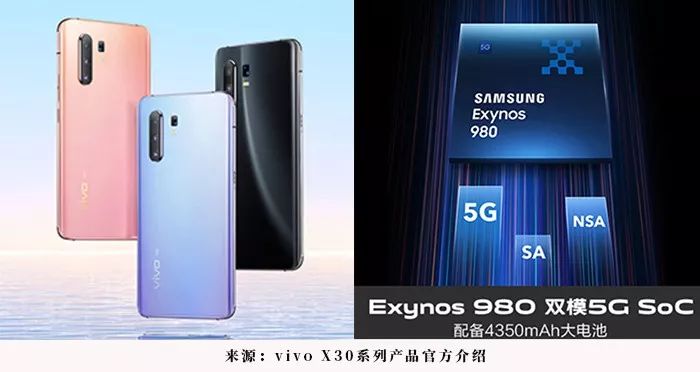Mobile phone manufacturers who have divided the market with 4G technology want to use 5G chips to redistribute the market structure.
 Production | Bullet Finance
Production | Bullet Finance
Author | Bo Yang Yang
Responsible Editor | Lin Zhong
This is a new battle.
Around the advent of the 5G era, major chip and mobile phone manufacturers have released their own chips and 5G mobile phones. For this new window, no one wants to be a laggard.
This is a crucial year.
Mobile phone manufacturers are actively embracing these 5G chip suppliers. Various words such as “independent research and development” and “joint research and development” have appeared before our eyes, and a new round of mobile phone wars triggered by the communication revolution is imminent.
Huawei has become a leader in the 5G era. It even kicked the oldest brother Qualcomm from the altar. In August this year, Huawei took the lead in releasing 5G plug-in chip solutions: Kirin 980+ Barron 5000, and then released the integrated 5G SoC chip Kirin 990 5G.
In this scramble, MediaTek is also constantly “passing the barriers” and released its first 5G SoC chip, MediaTek Teana 1000.
Qualcomm accidentally lost its voice. It was not until December 3 that Qualcomm held a press conference to announce the launch of the Qualcomm Snapdragon 865 flagship 5G chip and the Snapdragon 765G mid-range 5G chip.
1. Head chip maker “left behind”
In the two 5G chips released by Qualcomm, the Snapdragon 865 flagship 5G SoC chip does not integrate 5G baseband, but uses an external solution, but integrates a 5G SoC chip in the 765G chip.
Qualcomm said that the X55 5G baseband and radio frequency system is the world’s first commercial 5G baseband-to-antenna complete 5G solution that can provide peak downlink rates of up to 7.5Gbp.
Some regrets, although Qualcomm claims that the speed can reach 7.5Gbp, but because it uses a plug-in solution for 5G baseband, it is not integrated into the SoC, so it will not be better than integrated baseband in power control and signal stability.
Anmun explained, Qualcomm President said that enabling new 5G services requires the best performanceIf only the launch of 5G SoCs had to reduce the performance of either or both of them, so that the potential of 5G could not be fully realized, this is not worth the loss.

(Figure / Qualcomm official website )
From the 3G to 4G era, Qualcomm’s position in the chip is as strong as ever. Many domestic and foreign Android phone manufacturers basically use Qualcomm processors and baseband chips. These are two major advantages of Qualcomm, and it is these two that determine the success and failure of the mobile phone in terms of performance and signal.
From 2017, a protracted lawsuit battle broke out between Qualcomm and Apple, involving the United States, China, Germany and other countries and regions around the world. Until April 2019, this “Century War” finally ended in a handshake manner.
In this regard, both Qualcomm and Apple announced an agreement to dissolve all litigations between the two parties worldwide, and Apple will also pay a fee to Qualcomm. At the same time, the two parties also reached a six-year (two-year extension) technology license agreement and a multi-year chip supply agreement.
During the lawsuit between Qualcomm and Apple, Apple terminated the use of Qualcomm chips in its iPhones and switched to baseband chips from Intel, its other ally.
Because Intel has been involved in the mobile phone baseband chip market for a long time, it still lags behind Qualcomm in some patented technologies, but Apple’s use of Intel baseband chips is also a last resort, which has caused many users to talk.
Feedback from mobile phone signals, unstable data connections, and call interruptions has followed. Some mobile phone technicians believe that these conditions are caused by baseband chips, which pushed Intel to the pot.
 And it works on Qualcomm and Apple When it was impossible, Intel appeared as a savior in front of Apple. Apple has always wanted to use Intel’s baseband technology to confront Qualcomm, and it is also intensively conducting independent research and development of baseband chips.
And it works on Qualcomm and Apple When it was impossible, Intel appeared as a savior in front of Apple. Apple has always wanted to use Intel’s baseband technology to confront Qualcomm, and it is also intensively conducting independent research and development of baseband chips.
A few days ago, Apple has officially completed the acquisition of Intel’s baseband business. This acquisition will greatly enhance Apple’s self-development capabilities for 5G baseband chips.
According to Apple, it has included Intel ’s smart phone baseband business under its umbrella, and has obtained approximately 2200 employees and 17,000 patents. In this regard, Apple CEO Cook said: This is an opportunity to accelerate future product development, but also an opportunity to own and control the “core technology” behind its products.
Merrill Lynch analysts released a research report on future iPhone 5G mobile phone baseband chips. They believe that Apple’s self-developed 5G technology cannot catch up with Qualcomm by 2022. Before then, Qualcomm will receive 100% of iPhone baseband orders. After that, Qualcomm’s share will drop to 50%, and Apple will produce half of it.
An industry analyst said that after the acquisition of the Intel baseband business, Apple will work harder on its self-developed 5G baseband chips to fight against companies such as Huawei and Samsung of Qualcomm and Android camp, because they have their own 5G Baseband business.
2, the latecomer is on top
Unlike 3G and 4G, 5G, as a new communication technology, has higher performance requirements for chip and baseband collaboration. Therefore, integrating 5G baseband into SoC is a recognized practice in the industry.
So far, the only SoCs with integrated 5G baseband chips are the Huawei Kirin 990, MediaTek Teana 1000, Qualcomm 765G, and Samsung Exynos 980. 5G chips have entered a “four kingdoms killing” situation.
 Integrating a 5G SoC chip means that 5G modules can be truly integrated into the chip, resulting in lower power consumption and faster data transmission rates. The requirements are also more difficult, because they are not simply packaged together, but completely integrate the communication baseband module, CPU, and GPU.
Integrating a 5G SoC chip means that 5G modules can be truly integrated into the chip, resulting in lower power consumption and faster data transmission rates. The requirements are also more difficult, because they are not simply packaged together, but completely integrate the communication baseband module, CPU, and GPU.
“The integration solution will be the ultimate solution for 5G chips. The benefits it brings are obvious. I think that all manufacturers will adopt this solution in the future. But as the integration level increases, the technical threshold and investment will increase. Large, the price of chips will not drop much in the early stage. “A chip developer told” Bullet Finance “.
MediaTek CEO Cai Li said in an interview with the media: “It is estimated that this year’s R & D investment will reach 2 billion US dollars, accounting for 25% of revenue, and this proportion will not decrease as 5G matures in the future.”
According to “Bullet Finance”, MediaTek has invested US $ 8 billion in R & D in the past four years, and transferred 2,000-3000 R & D personnel to 5G and AI key areas. According to another report, Huawei alone invested more than 600 million US dollars in R & D for Kirin 990.
Since the integrated baseband chip solution is better than the external baseband chip, why did Qualcomm still choose the external baseband chip this time? An industry source said: “Because the plug-in is less difficult, it can better show the performance of its main chip.”
Since Huawei, Apple, and Samsung have begun to use self-developed chips, the Snapdragon series chips have not been their first choice products, so Qualcomm’s shipments have started to decline to varying degrees. In addition, Qualcomm’s current competitiveness continues to weaken, which can be answered from the shipment of Xiaomi’s flagship machine.
Qualcomm’s Q4 2019 financial report shows that its revenue was US $ 4.8 billion, down 17% year-on-year. In the quarter, Qualcomm sold a total of 152 million chips, a year-on-year decrease of 34%. The financial report predicts that the company’s chip shipments for the whole year of 2019 will be 608 million to 628 million, down 22% -24% year on year, the worst performance in nearly 5 years.
Qualcomm missed its first-mover advantage on 5G chips, just as Apple missed its first 5G phones.
Is it that Qualcomm changed its strategy and failed to play a flagship role in high-end chips, instead letting the “waist” chips replace them? However, in this battle for 5G chips, once they fail in the first batch of pits, they will let the latecomers take the lead.
3. Dilemma of self-developed chip
From the current chips used in 5G mobile phones, Huawei and Samsung’s high-end models basically use self-developed chips to replace Qualcomm chips, and Xiaomi, a “pro-high” series mobile phone brand, is gradually developing cooperation with multiple brands.
Under unprecedented pressure from the Chinese mobile phone market, some mobile phone manufacturers have begun to seek chip replacementsPlan or change the play on the chip.
At present, dual-mode 5G mobile phones equipped with Qualcomm chips have been successively shipped, and major manufacturers have also selected alliances in the 5G battlefield. “Bullet Finance” found that in the 5G era, the pattern of mobile phone manufacturers and chip manufacturers has begun to change.
Xiaomi began to cooperate with MTK (MediaTek), vivo began to cooperate with Samsung to jointly develop chips, and the entire demand side began diversified cooperation.
In vivo X30 series, vivo chose Samsung 5G chip Exynos 980, and carried out in-depth cooperation with Samsung to reach the pre-definition stage of the chip, while the previous vivo mobile phone chips mainly came from Qualcomm and MTK.

But the Exynos 980, which is developed by vivo and Samsung, is not Samsung ’s true foundation. It is more like an entry-level low-end 5G SoC with a veil. Samsung uses its own high-end in its products. 5G chip Exynos 990.
According to “Bullet Finance”, the Exynos 980 jointly developed by vivo and Samsung does not support UFS 3.0, which is commonly used in mid-range mobile phones, and only supports UFS 2.1. In terms of GPU or 5G technology, they all lag behind the existing 5G SoCs in the market.
In addition, in terms of GPU, Exynos 980 failed to integrate the latest Mali-G77 released by ARM, but the previous generation Mali-G76, with 5 computing units.
At present, Huawei Kirin 990, Qualcomm 765G, and 865G chips have adopted the latest GPU architecture, which also shows that vivo’s processor will be affected in terms of mobile phone applications and gaming experience, and the price of the machine is also far Higher than Redmi K30 5G version using Qualcomm 765G chip.
On the road to owning chips, the idea of self-developed chips is not only stored in vivo. OPPO had previously set up an integrated circuit design company. There are market rumors that OPPO’s first self-developed chip may be named OPPO M1.
“Self-developed chips ca n’t be completed overnight, and they need deep technical accumulation and accumulation.There are only two ways for your own chip: Either you buy a chip company like Apple, or you can cooperate with existing chip companies to develop in depth. “The industry source said.
4. The prelude to the scramble begins
On a few millimeters of chips, many top chip companies around the world are gathered. When the 5G era arrived, the fight between them was even more tragic than in the 4G era. The “taste of gunpowder” in a chip battle permeates the Chinese mobile phone market.
From Huawei Samsung’s “mutual rivalry” to MediaTek’s bid for Qualcomm, the pattern of 5G chips has changed from the beginning. No one wants to be left behind, they are all trying to be the leader of 5G mobile platform.
It is reported that MediaTek’s Teana 1000 will be officially mass-produced by the end of this year, and the first smartphone equipped with this flagship 5G SoC chip will also be commercially available in the first quarter of 2020.
In the overall mobile phone market, manufacturers of “Qualcomm” have also included MediaTek’s Teana 1000 in the purchase list. Some mobile phone manufacturers have stated that the use of external baseband power consumption is not good for control, and the motherboard has to be redesigned, which is “very difficult.”
“The most difficult thing for the team in this half year is 5G. Looking back at this half year, the most progress has been made. For example, joint tuning with operators on 5G. MediaTek, as a member of the ecological chain, has been actively contributing.” Manager Chen Guanzhou said in an interview with the media.

(Picture / MediaTek official website)
In 2013, MediaTek’s R & D accounted for 19% of revenue, and this year’s R & D expenses accounted for nearly 24%. Chen Guanzhou said, “When 5G just broke out, MediaTek’s expectation for 5G market share was higher than 4G.” He believes that with the introduction of more chip products, performance will continue to grow. For China’s market share, MediaTek’s target share is more than 50%.
According to the 2020 terminal product plan released by China Mobile, it is estimated that the scale of China’s 5G mobile phone market will exceed 150 million units in 2020. The price will drop to 1,000 yuan to 1,500 yuan in the fourth quarter, and the market will be dominated by 5G mobile phones. By 2022, 5G smartphone shipments will reach 1.4 billion.
It is foreseeable that the first echelon mobile phone brands of self-developed chips led by Huawei, Samsung and Apple have occupied the head market and gradually penetrated downward.
Headed by OPPO, vivo, XiaomiSecond-tier mobile phone brands that rely on Qualcomm, MTK, and Samsung chips will compete fiercely in the waist market.
“It is expected that in the first quarter of 2020, multiple chip platforms will launch multi-price segment products; in the second quarter, low-cost chips will be launched, and solution vendors will enter the market, driving down the price of 5G mobile phones. In terms of terminals, various vendors will launch in the first quarter. High-priced products; from June to July, 5G mobile phones were launched at around 2,000 yuan; in the fourth quarter, 5G mobile phone prices dropped to 1,000 yuan to 1,500 yuan. “Said Wang Hengjiang, deputy general manager of China Mobile Terminal Company.
Different chip manufacturers and mobile phone manufacturers have obviously released the same signal in treating 5G-occupying the top of the 5G industry. Each company has its own advantages in competitive play, and has also taken a different technical path.
Whether it is an external baseband chip, an integrated baseband chip, or a joint research and development chip, everyone’s starting point seems to focus on the two key words of 5G “leading” and “occupying the pit.”
Some people in the chip industry who asked not to be named believe: “This time, the competition between mobile phone chips is different from the past. 5G can enable both the C-side and the B-side, which is a large iteration of communication technology. So whether it is From the perspective of ordinary consumers or the industrial field, both provide opportunities and challenges for chip manufacturers. “
“At present, Qualcomm covers three product lines: high, medium and low, and has an advantage in the entire industry. Although other manufacturers have surpassed some products, the overall strength is not as good as Qualcomm.” Third-party analysis agency Counterpoint Greater China Research director Yan Zhanmeng said.
Yan Zhanmeng analyzed, “Although Huawei chips can achieve self-sufficiency, they are mainly concentrated in the low-end market and cannot surpass Qualcomm in the short term. In addition, Samsung has obvious advantages over other manufacturers, both in the screen and the chip Achieve self-sufficiency and higher matching of each component. “
Facing today’s 5G market, no one manufacturer will give up this cup. Looking back at the development of China’s communications industry, from the chip to the entire industry, from 2G 20 years ago to 5G today, the technology is constantly changing, and the application of products using newer communications technology is growing like bamboo shoots, and it is constantly emerging.
Mobile phone makers that divide the market with 4G technology are now redistributing the market with 5G. The global 5G chip manufacturers and mobile phone manufacturers are gradually gathering heads. Future competition in the chip or mobile phone market will further widen their distance.
A new battle for chip and mobile phone market structure has begun.
The title map and department allocation map in this article come from: Photograph Network, based on VRF authorization.